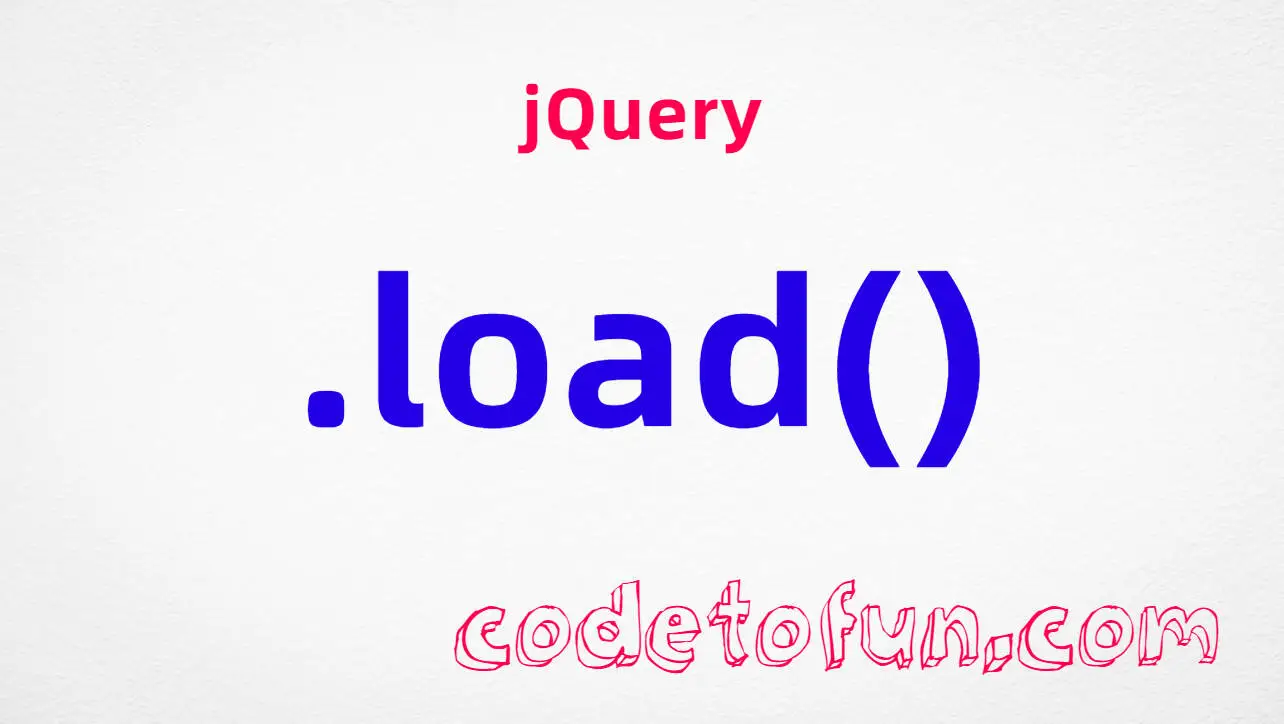
jQuery Basic
jQuery Ajax Events
- jQuery ajaxComplete
- jQuery ajaxError
- jQuery ajaxSend
- jQuery ajaxStart
- jQuery ajaxStop
- jQuery ajaxSuccess
jQuery Ajax Methods
- jQuery .ajaxComplete()
- jQuery .ajaxError()
- jQuery .ajaxSend()
- jQuery .ajaxStart()
- jQuery .ajaxStop()
- jQuery .ajaxSuccess()
- jQuery jQuery.ajax()
- jQuery jQuery.ajaxPrefilter()
- jQuery jQuery.ajaxSetup()
- jQuery jQuery.ajaxTransport()
- jQuery jQuery.get()
- jQuery jQuery.getJSON()
- jQuery jQuery.param()
- jQuery jQuery.post()
- jQuery .load()
- jQuery .serialize()
- jQuery .serializeArray()
jQuery Keyboard Events
jQuery Keyboard Methods
jQuery Form Events
jQuery Form Methods
- jQuery .blur()
- jQuery .change()
- jQuery .focus()
- jQuery .focusin()
- jQuery .focusout()
- jQuery .select()
- jQuery .submit()
jQuery Mouse Event
- jQuery click
- jQuery contextmenu
- jQuery dblclick
- jQuery mousedown
- jQuery mouseenter
- jQuery mouseleave
- jQuery mousemove
- jQuery mouseout
- jQuery mouseover
- jQuery mouseup
jQuery Mouse Methods
- jQuery .click()
- jQuery .contextmenu()
- jQuery .dblclick()
- jQuery .hover()
- jQuery .mousedown()
- jQuery .mouseenter()
- jQuery .mouseleave()
- jQuery .mousemove()
- jQuery .mouseout()
- jQuery .mouseover()
- jQuery .mouseup()
- jQuery .toggle()
jQuery Event Object
- jQuery currentTarget
- jQuery data
- jQuery delegateTarget
- jQuery isDefaultPrevented()
- jQuery isImmediatePropagationStopped()
- jQuery isPropagationStopped()
- jQuery metakey
- jQuery namespace
- jQuery pageX
- jQuery pagey
- jQuery preventDefault()
- jQuery relatedTarget
- jQuery result
- jQuery stopImmediatePropagation()
- jQuery stopPropagation()
- jQuery target
- jQuery timeStamp
- jQuery type
- jQuery which
jQuery .load() Method

Photo Credit to CodeToFun
🙋 Introduction
jQuery is renowned for its simplicity and power in manipulating HTML elements and handling asynchronous events. One of its versatile methods is .load(), which facilitates the seamless loading of data from the server and injecting it into the DOM. Understanding and mastering the .load() method can significantly enhance your web development capabilities.
In this guide, we'll delve into the intricacies of the jQuery .load() method, providing clear examples to illustrate its functionality.
🧠 Understanding .load() Method
The .load() method in jQuery is primarily used to fetch HTML content from the server and insert it into the selected element(s) without reloading the entire page. This method simplifies the process of dynamically updating parts of a web page, making it ideal for implementing features like infinite scrolling, AJAX navigation, and live content updates.
💡 Syntax
The syntax for the .load() method is straightforward:
$(selector).load(url [, data] [, complete]);Parameters:
- url: Specifies the URL from which to fetch the content.
- data (optional): An object containing data to be sent to the server.
- complete (optional): A callback function to be executed when the
.load()method completes.
📝 Example
Loading External HTML Content:
Let's say you have a <div> element with the ID #result, and you want to load content from an external HTML file external.html into it.
index.htmlCopied<div id="result">Placeholder text</div>example.jsCopied$("#result").load("external.html");This will replace the content of the #result div with the contents of external.html.
Loading Data with Parameters:
You can also pass data to the server along with the request. For instance, let's load content from a server-side script (load_data.php) that accepts parameters.
example.jsCopied$("#result").load("load_data.php", { key1: "value1", key2: "value2" });This will send the data { key1: "value1", key2: "value2" } to load_data.php and replace the content of #result with the response.
Handling Callbacks:
You can execute a function once the
.load()operation is complete by providing a callback function. For example:example.jsCopied$("#result").load("external.html", function() { console.log("Content loaded successfully!"); });This will log "Content loaded successfully!" to the console after the content is loaded into #result.
Loading Specific Sections:
If you only want to load specific sections of the external content, you can specify a selector after the URL. For instance:
example.jsCopied$("#result").load("external.html #specificSection");This will only load the content of the element with the ID specificSection from external.html.
🎉 Conclusion
The jQuery .load() method offers a convenient way to fetch and inject HTML content from the server, making dynamic updates to web pages a breeze. Whether you're fetching external content, passing data to the server, or executing callbacks upon completion, this method streamlines the process of asynchronous content loading.
By mastering its usage, you can create more responsive and engaging web applications effortlessly.
👨💻 Join our Community:
Author

For over eight years, I worked as a full-stack web developer. Now, I have chosen my profession as a full-time blogger at codetofun.com.
Buy me a coffee to make codetofun.com free for everyone.
Buy me a Coffee











